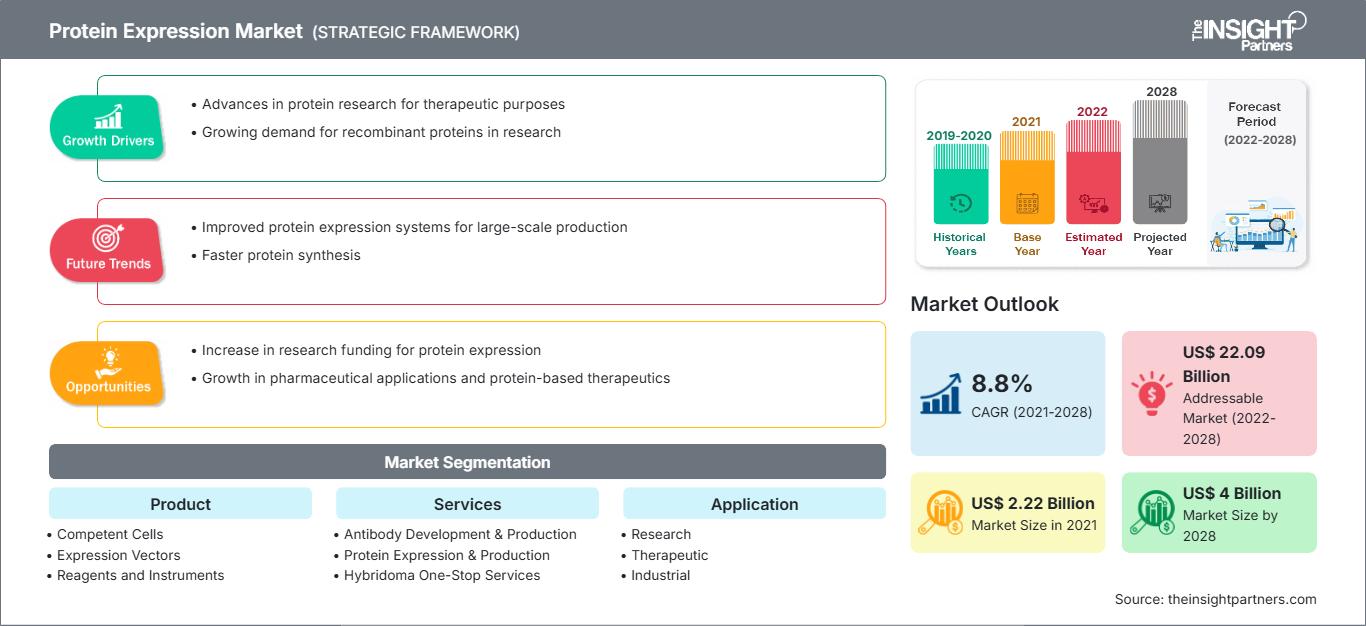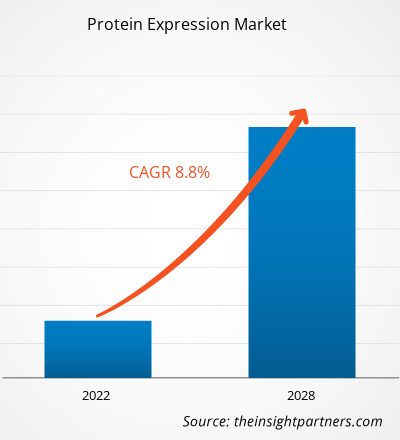Der Markt für Proteinexpression wird voraussichtlich von 2.221,73 Millionen US-Dollar im Jahr 2021 auf 4.000,67 Millionen US-Dollar im Jahr 2028 anwachsen. Der Markt wird voraussichtlich zwischen 2021 und 2028 mit einer durchschnittlichen jährlichen Wachstumsrate (CAGR) von 8,8 % wachsen.
Der Markt für Proteinexpression umfasst Produkttyp, Dienstleistungen, Anwendung, Endbenutzer und Region. Basierend auf den Regionen ist der Markt für Proteinexpression in Nordamerika, Europa, Asien-Pazifik, Naher Osten und Afrika sowie Süd- und Mittelamerika unterteilt. Der Bericht bietet Einblicke und eine eingehende Analyse des Marktes für Proteinexpression und legt dabei den Schwerpunkt auf verschiedene Parameter wie Markttrends, technologische Fortschritte, Marktdynamik und eine Analyse der Wettbewerbslandschaft führender Marktteilnehmer weltweit. Er enthält auch eine Analyse der Auswirkungen von COVID-19 auf die Regionen.
Markteinblicke: Zunehmende Anwendungsmöglichkeiten der Proteinexpression
Die Proteinexpression, ein integrales Werkzeug in der biologischen Forschung, gewinnt als pharmazeutischer Produktionsmechanismus für biologische Therapeutika zunehmend an Bedeutung. Die Kombination aus alten Technologien, wie künstlichen Enzymen, und neuen Expressionssystemen der nächsten Generation belebt Proteinexpressionsprotokolle neu. Die Entwicklung der Gentechnik und des Klonens hat viele Möglichkeiten für die Expression und Isolierung heterologer Proteine für Forschungszwecke eröffnet. Beträchtliche technologische Fortschritte haben die Expression und Isolierung rekombinanter Proteine im großen Maßstab ermöglicht.
Die Nachfrage nach rekombinanten Proteinen für die Anwendung am Menschen steigt täglich. Es besteht eine enorme Nachfrage nach neuen und verbesserten Bioprozessstrategien, die kostengünstig und zeitsparend sind. Die kontinuierliche Verbesserung biopharmazeutischer Expressionssysteme hat zur Herstellung hochwertiger Produkte geführt. Moderne molekularbiologische Techniken stehen bei der Produktion biopharmazeutischer Proteine unter Verwendung verschiedener prokaryotischer oder eukaryotischer Expressionssysteme an vorderster Front. Verschiedene innovative Techniken, wie Systembiologie, Stoffwechseltechnik und CRISPR/Cas-Systeme, können für die Stammtechnik eingesetzt werden, um die Leistung von Bioprozessen zu verbessern und biologisch aktive und stabile Proteine zu erzeugen.
Passen Sie diesen Bericht Ihren Anforderungen an
Sie erhalten kostenlos Anpassungen an jedem Bericht, einschließlich Teilen dieses Berichts oder einer Analyse auf Länderebene, eines Excel-Datenpakets sowie tolle Angebote und Rabatte für Start-ups und Universitäten.
Markt für Proteinexpression: Strategische Einblicke

- Holen Sie sich die wichtigsten Markttrends aus diesem Bericht.Dieses KOSTENLOSE Beispiel umfasst Datenanalysen, die von Markttrends bis hin zu Schätzungen und Prognosen reichen.
Sie erhalten kostenlos Anpassungen an jedem Bericht, einschließlich Teilen dieses Berichts oder einer Analyse auf Länderebene, eines Excel-Datenpakets sowie tolle Angebote und Rabatte für Start-ups und Universitäten.
Markt für Proteinexpression: Strategische Einblicke

- Holen Sie sich die wichtigsten Markttrends aus diesem Bericht.Dieses KOSTENLOSE Beispiel umfasst Datenanalysen, die von Markttrends bis hin zu Schätzungen und Prognosen reichen.
Die globale Belastung durch Denguefieber nimmt rapide zu und wird so lange anhalten, bis ein wirksamer Impfstoff dagegen entwickelt ist. Verschiedene Impfstoffkandidaten gegen Denguefieber befinden sich in der präklinischen und klinischen Entwicklungsphase und basieren auf unterschiedlichen Ansätzen. Einige Impfstoffe sind tetravalente, abgeschwächte Lebendviren, gereinigte inaktivierte Viren, rekombinante Proteinuntereinheiten, Plasmid-DNA und virusbasierte Dengue-Impfstoffe. Jüngste Fortschritte bei rekombinanten Untereinheiten-basierten Dengue-Impfstoffkandidaten unter Verwendung verschiedener Ansätze, wie der Fusion mit anderen immunogenen Epitopen, der Verwendung eines neuartigen Adjuvans, der Proteinexpression in verschiedenen Wirtssystemen, Designer-Impfstoffen und der Entwicklung von VLPs, eröffnen neue Wege für die Entwicklung eines voll wirksamen Impfstoffs gegen Denguefieber.
Derzeit werden mehr als 65 Millionen bestätigte Fälle und über 1,5 Millionen Todesfälle gemeldet. Die COVID-19-Pandemie hat zu erheblichen gesundheitlichen, sozialen und globalen Wirtschaftskrisen geführt. Die Entwicklung eines Impfstoffs gegen COVID-19 ist eine wirksame Strategie zur Eindämmung des Ausbruchs. Der Impfstoff muss schnell produziert werden und leicht skalierbar sein. Um die Produktionszeit zu verkürzen, müssen rekombinante Protein-, virale Vektor- oder Nukleinsäure-basierte (rekombinante Plasmid-DNA und mRNA) Impfstoffe in Betracht gezogen werden. Aufgrund der Vorteile rekombinanter Proteine nimmt die Proteinexpression bei der Impfstoffentwicklung zu, was das Wachstum des Proteinexpressionsmarktes vorantreibt.
Produkttypbasierte Einblicke
Basierend auf dem Produkttyp ist der Proteinexpressionsmarkt in Instrumente, Reagenzien, Expressionsvektoren und kompetente Zellen unterteilt. Das Reagenziensegment hatte 2021 den größten Marktanteil. Außerdem wird das Reagenziensegment im Prognosezeitraum voraussichtlich die höchste durchschnittliche jährliche Wachstumsrate (CAGR) von 9,5 % verzeichnen.
Servicebasierte Einblicke
Basierend auf den Dienstleistungen ist der Proteinexpressionsmarkt in Antikörperentwicklung & Produktion, Proteinexpression und -produktion, Hybridom-One-Stop-Services, Entwicklung stabiler Zelllinien, bioanalytische Testservices. Das Segment Antikörperentwicklung und -produktion hatte 2021 den größten Marktanteil. Es wird jedoch geschätzt, dass dasselbe Segment im Prognosezeitraum die höchste CAGR von 9,7 % auf dem Markt verzeichnet.
Anwendungsbasierte Erkenntnisse
Basierend auf der Anwendung ist der Markt für Proteinexpression in Forschung, Therapie und Industrie segmentiert. Das therapeutische Segment hatte 2021 den größten Marktanteil und es wird geschätzt, dass dasselbe Segment im Prognosezeitraum die höchste CAGR von 9,4 % auf dem Markt verzeichnet.Endbenutzerbasierte Erkenntnisse
Basierend auf dem Endbenutzer ist der Markt für Proteinexpression in Pharma- und Biotechnologieunternehmen, akademische Forschungsinstitute und Auftragsforschungsinstitute segmentiert. Das Segment der Pharma- und Biotechnologieunternehmen hatte 2021 den größten Marktanteil. Zudem wird für dieses Segment im Prognosezeitraum die höchste durchschnittliche jährliche Wachstumsrate (CAGR) von 5,6 % erwartet.
Unternehmen setzen häufig auf anorganische Strategien wie Partnerschaften, Fusionen und Übernahmen, um der veränderten Kundennachfrage gerecht zu werden und ihren Markennamen weltweit zu behaupten. Marktteilnehmer im Markt für Proteinexpression setzen zudem auf organische Strategien wie Produkteinführungen und -expansion, um ihre Präsenz und ihr Produktportfolio weltweit zu erweitern und die wachsende Nachfrage zu decken.
ProteinexpressionRegionale Einblicke in den Proteinexpressionsmarkt
Die Analysten von The Insight Partners haben die regionalen Trends und Faktoren, die den Proteinexpressionsmarkt im Prognosezeitraum beeinflussen, ausführlich erläutert. In diesem Abschnitt werden auch die Marktsegmente und die geografische Lage in Nordamerika, Europa, dem asiatisch-pazifischen Raum, dem Nahen Osten und Afrika sowie Süd- und Mittelamerika erörtert.
Umfang des Marktberichts zur Proteinexpression
| Berichtsattribut | Einzelheiten |
|---|---|
| Marktgröße in 2021 | US$ 2.22 Billion |
| Marktgröße nach 2028 | US$ 4 Billion |
| Globale CAGR (2021 - 2028) | 8.8% |
| Historische Daten | 2019-2020 |
| Prognosezeitraum | 2022-2028 |
| Abgedeckte Segmente |
By Produkt
|
| Abgedeckte Regionen und Länder | Nordamerika
|
| Marktführer und wichtige Unternehmensprofile |
|
Dichte der Marktteilnehmer im Bereich Proteinexpression: Verständnis ihrer Auswirkungen auf die Geschäftsdynamik
Der Markt für Proteinexpression wächst rasant, angetrieben durch die steigende Endverbrauchernachfrage aufgrund von Faktoren wie sich entwickelnden Verbraucherpräferenzen, technologischem Fortschritt und einem stärkeren Bewusstsein für die Produktvorteile. Mit steigender Nachfrage erweitern Unternehmen ihr Angebot, entwickeln Innovationen, um den Verbraucherbedürfnissen gerecht zu werden, und nutzen neue Trends, was das Marktwachstum weiter ankurbelt.

- Holen Sie sich die Markt für Proteinexpression Übersicht der wichtigsten Akteure
- Kompetente Zellen
- Expressionsvektoren
- Reagenzien
- Instrumente
Nach Dienstleistungen
- Antikörperentwicklung und -produktion
- Proteinexpression und -produktion Produktion
- Hybridom-Komplettservices
- Entwicklung stabiler Zelllinien
- Bioanalytische Testservices
Nach Anwendung
- Forschung
- Therapeutisch
- Industriell
Nach Endnutzer
- Pharma- und Biotechnologieunternehmen
- Auftragsforschungsinstitute
- Akademische Forschungsinstitute
- Sonstige
Nach Geografie
- Nordamerika
- USA
- Kanada
- Mexiko
- China
- Indien
- Südkorea
- Japan
- Australien
- Rest von APAC
- Südafrika
- Saudi-Arabien
- VAE
- Rest von MEA
- Brasilien
- Argentinien
- Rest von SCAM
Firmenprofile
- Thermo Fisher Scientific, Inc.
- GenScript
- Merck KGaA
- Agilent Technologies, Inc.
- Takara Bio Inc.
- Bio-Rad Laboratories, Inc.
- QIAGEN
- New England Biolabs.
- Promega Corporation
- Oxford Expression Technologies Ltd
- Historische Analyse (2 Jahre), Basisjahr, Prognose (7 Jahre) mit CAGR
- PEST- und SWOT-Analyse
- Marktgröße Wert/Volumen – Global, Regional, Land
- Branchen- und Wettbewerbslandschaft
- Excel-Datensatz
Aktuelle Berichte
Erfahrungsberichte
Grund zum Kauf
- Fundierte Entscheidungsfindung
- Marktdynamik verstehen
- Wettbewerbsanalyse
- Kundeneinblicke
- Marktprognosen
- Risikominimierung
- Strategische Planung
- Investitionsbegründung
- Identifizierung neuer Märkte
- Verbesserung von Marketingstrategien
- Steigerung der Betriebseffizienz
- Anpassung an regulatorische Trends




















 Kostenlose Probe anfordern für - Markt für Proteinexpression
Kostenlose Probe anfordern für - Markt für Proteinexpression